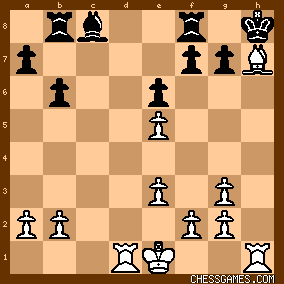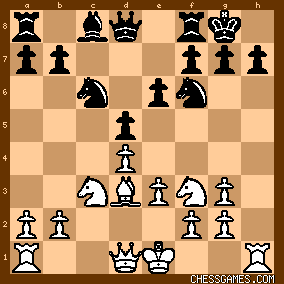|
< Earlier Kibitzing · PAGE 2 OF 2 ·
Later Kibitzing> |
| Mar-14-18 | | Mayankk: I had White winning a pawn by switching the order of moves - Bxh7+, Nxh7 followed by Ne5, when most likely Black will have to retreat it’s knight, back to f6 and White can play Nxc6 to gain a pawn. It was amazing to see how a simple swap of first two moves made the attack so much more potent. It’s the same mix of attacking ideas, just a minor twist in execution. |
|
| Mar-14-18 | | SpamIAm: Some Xharp tactics here. ;)
Certainly 11...g6 would blunt the force of White's attack. Perhaps the puzzle should start at the 12th move, after Black's rather passive 11...Bb7. |
|
| Mar-14-18 | | EIDorado: @SpamIAm It's correct as it is, the c6 knight has to be defended, so 11. ... g6 doesn't work. I didn't get it either, so you're not alone. |
|
| Mar-14-18 | | bcokugras: What happens if 12. ... Nxh7? |
|
Mar-14-18
 | | An Englishman: Good Evening: 12...Nxh7; 13.Qh5,Re8; 14.Qxh7+,Kf8; 15.Qh8+,Ke7; 16.Qxg7 and the f-pawn also falls (16...Rf8; 17.Ng6+). 9...Bxg3 was weak, and 10...b6 proved disastrous. But that's the funny thing about the Exchange Slav; the most boring opening in all of chess has a lot of poison. |
|
| Mar-14-18 | | diagonalley: the key, of course, being to foresee the royal fork... drat, and double drat :-( |
|
| Mar-14-18 | | agb2002: The material is identical.
The white bishop and the rook on h1 converge on h7, the knight on c6 and the rook on a8 are defenseless and the knight on f3 blocks Qh5. These details suggest 11.Ne5: A) 11... Nxe5 12.dxe5 (12.Bxh7+ Nxh7 13.Qh5 f6 14.Qxh7+ Kf7 15.dxe5 fxe5 doesn't seem to achieve much for White) 12... Ne4 (12... Nd7 13.Bxh7+ Kh8 14.Qh5 + -) 13.Nxe4 dxe4 14.Bxe4 Qxd1+ 15.Rxd1 Rb8 16.Bxh7+ + - [2P]. B) 11... Bb7 12.Bxh7+
B.1) 12... Nxh7 13.Qh5 Re8 14.Qxh7+ Kf8 15.Qh8+ Ke7 16.Qxg7 Nxe5 17.Qxe5 + - [2P]. B.2) 12... Kh8 13.Bg6+ Kg8 14.Bxf7+ Rxf7 15.Rh8+ Kxh8 16.Nxf7+ Kg8 17.Nxd8 + - [Q+P vs b+n]. |
|
| Mar-14-18 | | wondairfoul: Could anybody answer to Bcokugras "what happens if 12. ...Nxh7 ?" thanks |
|
Mar-14-18
 | | rodchuck: If 12... Nxh7 13. Qh5 looks strong |
|
| Mar-14-18 | | Walter Glattke: 11.Bxh7+? Nxh7 12.Rxh7 Kxh7 13.Ng5+ Kg6!
14.Qg5 f5! |
|
| Mar-14-18 | | latebishop: I think that after 12...Nxh7 13 Qh5 Re8 (clearly forced), White actually has mate by 14.Qxf7+ Kh8 15. Qg6 Kg8 16. Qh7+ Kf8 17.Qh8+ Ke7 18.Q×g7+ Kd6 19.Nb5++ |
|
| Mar-14-18 | | saturn2: Like in the game I took 11 Ne5 opening the diagonal d1-h5 for the queen. However if black defends well white would only get a pawn plus attack. Black has 11..Ne7, Qc7, Bb(d)7 or NxNe5 but white can let Bxh7 follow soon with the beforementioned outcome. |
|
| Mar-14-18 | | patzer2: Tough problem (11. ?) for a Wednesday puzzle. The tempting demolition 11. Bxh7+ Nxh7 12. Ne5! Nxe5 13. Qh5 ± is no where near as strong as the game continuation 11. Ne5! +-. I didn't play either of those moves because I didn't consider 11. Ne5! and I couldn't see a clear winning continuation after 11. Bxh7+!? ±. Instead, I went for 11. g4, hoping for 11...h6 12. g5 ± with a strong attack. Unfortunately after 11. g4 g6 12. Rh4 ± Black's defenses are much tougher to crack open. At least I had the right idea in using a move (i.e 11. g4 ±) to try and prepare a winning combination. I just didn't see 11. Ne5! +- was the only sure way to prepare a decisive demolition sham sacrifice on h7, or that 11. g4 is a really tough nut to crack after 11. g4 g6. P.S.: Black's decisive mistake was 10...b6, allowing the strong positional and tactical move 11. Ne5! +-. Instead, 10...g6 = to ⩲ (+0.25 @ 29 ply, Stockfish 9) keeps the position about level. I should have considered 11. Ne5! on a purely positional basis. The e5 post is the strongest square for the Knight, and it cannot be safely captured due to the threat 11...Nxe5? 12. dxe5 +-. |
|
| Mar-14-18 | | patzer2: For an off the beaten path try for Black in this opening, the computer move 6...Nh5 = as in Black's win in Di Li vs C Holt, 2018 might be worthy of consideration. |
|
| Mar-14-18 | | gofer: Well, I must have got this one completely wrong. All it does is win
two pawns (probably three) and move into a won endgame. Pity! I couldn't get the bishop sac to work, so instead I played the
longterm strategy of always threatening the bishop sacrifice,
but never getting to play it...
<11 Ne5 ...>
Black has no time to defend or remove the knight from danger... 11 ... Nb4/Ne7/Bd7/Bb7
12 Bxh7+ Kh8 (Nxh7? Qh5 mating)
13 Bg6+ Kg8 (Nh7? Qh5 mating)
14 Bxf7+! Rxf7
15 Rh8+! Kxh8
16 Nxf7+ +-
<11 ... Nxe5>
<12 dxe5 ...>
I prefer this to the continuation of Bxh7+ immediately which wins too,
but keeps the queens on the board and seems more difficult to work out.
Nf6 must move and anywhere but Nd4 allows Bxh7+ followed by Qh5 mating! <12 ... Nd4>
13 f3 looks interesting, but it blocks Qh5, so it's not a good idea probably, but
it might work... 13 f3 Nxc3 14 Bxh7+ Kh8 15 bxc3 any move 16 Kd2 threatening 17 Bg6+
Kg8 18 Rh8+ Kxh8 19 Qh1+ mating.
<13 Nxd4 exd4>
<14 Bxd4 ...>
The whole sequence looks forced. White now threatens Bxh7+ mating and also
Bxa8 winning easily. So I think the queen exchange is forced. <14 ... Qxd1+>
<15 Rxd1 ...>
Now, 16 Bxh7+ no longer threatens mate, but its still a huge threat!
(i.e. 15 ... Ba6? 16 Bxh7+ Kh8 17 Bd3+! Kg8 18 Bxa6 +-) <15 ... Rb8>
<16 Bxh7+ Kh8>

click for larger viewWhite is already two pawns up with a discovered check that is more than likely going to net one more pawn from the discovered check (i.e. 1 ... g6 2 Bxg6+), but really black's position is really quite difficult while the dicovered check still exists (i.e. 17 ... Bb7? and 17 ... Rd8) are horrible choices. The simple rook lift looks to be really strong... <17 Rd4! ...>
~~~
Wow, I wasn't as wrong as I thought, but more like a <Saturday> than a humble
<Wednesday>!
Nice to see that <agb2002> agrees! |
|
| Mar-14-18 | | SpamIAm: <EIDorado>- Boy, am I tired. Missing obvious needed defense. Oh well. |
|
| Mar-14-18 | | morfishine: I got <11.Ne5> which is standard stuff chasing Black's Knight away if Black captures 11...Nxe5 then 12.dxe5 But thats as far as I looked, too much going on, March madness is here! ***** |
|
| Mar-14-18 | | wtpy: Saw 12 Ne5 but didn't consider 12..Bb7, but when confronted with this move went with 13 Bh7 Kh1 14 Bb1 Kg8 15 g4 which should win, with white playing the maneuver Qf3 followed by Qh6 and breaking through on h file. Too much work for a Wednesday. |
|
| Mar-14-18 | | takchess: missed it . Just because I can sac a bishop doesn't mean I should. I wonder if I thought of the principle: Bring more pieces into an attack that would of help. A sweet tactic I need to look at closer. A good find by FSR. |
|
| Mar-14-18 | | cormier: 
click for larger viewAnalysis by Houdini 4
10...h6 11.Rc1 Bd7 12.0-0 Qb8 13.Bb1 Qd6 14.Qd3 Rac8 15.a3 a6 16.Rfe1 e5 17.dxe5 Nxe5 18.Nxe5 Qxe5 19.Ba2 Be6 20.Qd4 Qxd4 21.exd4 Rfe8 22.f3 g6 23.g4 Kg7 24.Kf2 b5 25.Rh1 Rc7 26.Ne2
= (0.14) Depth: 24
...
patzer2:
P.S.: Black's decisive mistake was 10...b6, allowing the strong positional and tactical move 11. Ne5! +-. Instead, 10...g6 = to ⩲ (+0.25 @ 29 ply, Stockfish 9) keeps the position about level. |
|
| Mar-14-18 | | cormier: that was deep positional analysis too
...

click for larger viewAnalysis by Houdini 4
<6...a6> 7.Rc1 Bf5 8.e3 e6 9.Bd3 Bxd3 10.Qxd3 Bd6 11.Bxd6 Qxd6 12.0-0 Nd7 13.Na4 0-0 14.a3 f6 15.Nc5 Nxc5 16.dxc5 Qe7 17.b3 a5 18.h3 Ne5 19.Nxe5 fxe5 20.f3 Rac8 21.b4 Qg5 22.bxa5 Rf5
<= (0.19) Depth: 26 dpa> |
|
| Mar-14-18 | | JJF: Anyone tell me the purpose of 8. Bg3? |
|
| Mar-14-18 | | NBZ: <An Englishman>: Maybe even stronger after 12. ... Nxh7 13. Qh5 Re8 is 14. Qxf7+ Kh8 15. Qh5 Kg8 (forced) 16. Qxh7+ Kf8 17. Qh8+ Ke7 18. Qxg7+ Kd6 19. Nb5#. |
|
| Mar-14-18 | | princecharming: Actually after 12...Nxh7, White has mate in 3: 13.Qh5 Re8 14.Qxf7+ Kh8 15.Ng6# |
|
| Mar-14-18 | | princecharming: Scratch that--mate in 4 if you throw in the computer move 13...Qh4. Here's the line: 12...Nxh7 13.Qh5 Qh4 14.Rxh4 Rfe8 15.Qxf7+ Kh8 16.Ng6# |
|
 |
|
< Earlier Kibitzing · PAGE 2 OF 2 ·
Later Kibitzing> |





